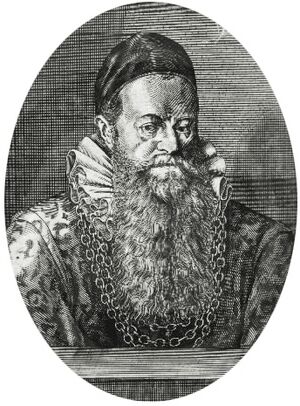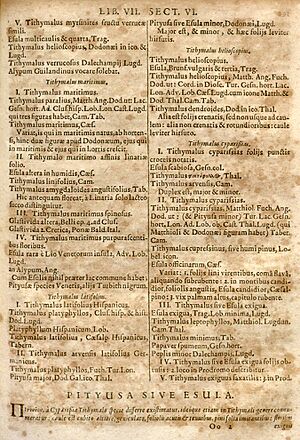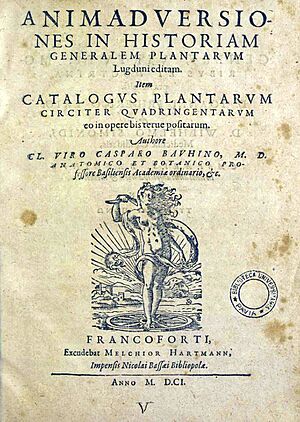Gaspard Bauhin facts for kids
Quick facts for kids
Gaspard Bauhin
|
|
|---|---|
 |
|
| Born | 17 January 1560 Basel, Switzerland
|
| Died | 5 December 1624 (aged 64) Basel, Switzerland
|
| Other names | Caspar Bauhin; Casparus Bauhinus |
| Alma mater | University of Basel (M.D., 1581) |
| Known for | Pinax theatri botanici |
| Scientific career | |
| Fields | Botany |
| Notable students | Emmanuel Stupanus |
| Author abbrev. (botany) | C.Bauhin |
Gaspard Bauhin (born January 17, 1560 – died December 5, 1624) was a famous Swiss scientist. He was a botanist, which means he studied plants. He also worked on human anatomy, which is the study of the body's structure.
His most famous book was Pinax theatri botanici (published in 1623). In this book, he described thousands of plants. He also classified them in a way that was similar to how Linnaeus later named plants using two names (called binomial nomenclature).
Gaspard Bauhin was the brother of another famous botanist, Jean Bauhin. Carl Linnaeus later honored both brothers by naming a group of plants, Bauhinia, after them.
Contents
A Life Dedicated to Science
Gaspard and his brother Jean were the sons of Jean Bauhin (1511–1582). Their father was a French doctor. He had to leave his home country because he became a Protestant. Gaspard was born in Basel, Switzerland.
Early Studies and Education
From 1572, Gaspard studied in his hometown of Basel. He also studied in many other important European cities. These included Padua, Bologna, Montpellier, Paris, and Tübingen. He earned his medical doctorate from the University of Basel in 1581. After that, he started giving private lessons in botany and anatomy.
University Career and Leadership
In 1582, he became a professor of Greek at the University of Basel. By 1588, he was given the important job of professor of anatomy and botany. He later became the city's doctor (called Stadtarzt in German). He also became a professor of medicine.
Gaspard Bauhin was chosen to be the rector (head) of the University of Basel three times. He was rector in 1592, then again in 1611, and finally in 1619. During his time as rector, he tried to get back some freedoms for the university. These freedoms had been lost many years before.
Important Works and Contributions

Gaspard Bauhin's book, Pinax theatri botanici, is a very important book in the history of botany. Its English title means Illustrated exposition of plants. This book described about 6,000 different kinds of plants. It also classified them into groups.
Plant Classification and Naming
Bauhin's classification system was not completely new. He used traditional groups like "trees," "shrubs," and "herbs." He also grouped plants by how they were used, such as putting spices together in a group called Aromata. However, he did correctly group some plants, like grasses and legumes.
His biggest contribution was how he described plant groups (genera) and individual plants (species). He introduced many plant names that Linnaeus later used. Many of these names are still used today. For species, he made the descriptions very short. Sometimes, just one word was enough to describe a plant. This made his names look like the two-part names (binomials) that Linnaeus later made famous.
Other Publications
Besides Pinax Theatri Botanici, Gaspard Bauhin planned another huge work called Theatrum Botanicum. This was meant to be twelve large parts. He finished three parts, but only one was published. It came out in 1658, long after he had died.
He also wrote a detailed list of plants growing around Basel. This type of list is called a flora. He also edited the works of another famous botanist, Pietro Andrea Mattioli (1500–1577). Bauhin added a lot of new information to Mattioli's books. His main work on anatomy was called Theatrum Anatomicum infinitis locis auctum (1592).
Main Publications
- (as editor), Petri Andreae Matthioli Opera Omnia, Johannes König, Basel, 1574.
- Theatrum anatomicum infinitis locis auctum, ad morbos accommodatum, Basel, 1592.
- Anatomica corporis virilis et muliebris historia, Leiden, 1597.
- Pinax theatri botanici, Basel, 1623.
- Theatrum Botanicum, 1658.
- Histoire des plantes de l’Europe, et des plus usitées qui viennent d’Asie, d’Afrique, & de l’Amérique […], 2 voll., Lyon, 1671.
See also
 In Spanish: Caspar Bauhin para niños
In Spanish: Caspar Bauhin para niños


